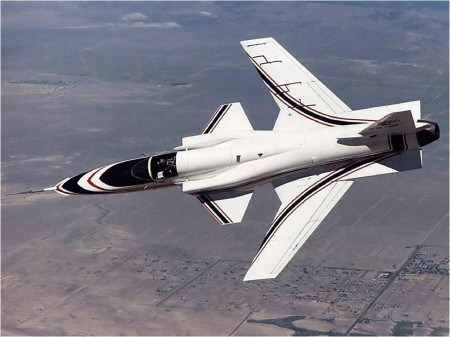Twenty-eight years ago this month, the first DARPA/Grumman X-29A Forward Swept Wing experimental aircraft took to the air. The flight originated from Edwards Air Force Base with Grumman Chief Test Pilot Chuck Sewell at the controls.
The X-29A was designed to flight test the forward-swept wing (FSW) concept as applied to a fighter-type aircraft. The theoretical merits of this concept include greater agility, slower stall speeds, higher spin resistance, and better low-speed flight control relative to an aft-swept wing (ASW).
A key attribute of the FSW is that spanwise flow is directed from the wing tip toward the wing root. The result is that the wing root stalls before the wing tip at high angle-of-attack. This is advantageous in that a root stall is a more controllable flow condition than is a tip stall.
Due to the FSW’s inward spanwise flow, the outboard-located ailerons retain full control effectiveness since they remain in high energy air. Additionally, wing tip vortex strength is reduced and the associated drag-to-lift decreased. This results in better fuel economy and increased range performance.
Of course, these and other FSW benefits come at a price. The primary issue is related to wing structural dynamic characteristics. Due to the elastic nature of the wing structure, lift on a FSW tends to bend the wing tips upward. This deflection causes an increase in wing tip lift, which causes further bending. This problem becomes more severe with increasing aircraft speed.
The divergent structural response noted above will eventually cause the wing to structurally fail unless it is built strong enough to resist bending. Prior to the X-29A, the only solution to the FSW aeroelastic problem was to build a structually-strong, but very heavy wing. The X-29A would solve this problem through the medium of high-strength, lightweight composite wing construction.
The X-29A used an aeroelastically-tailored wing to provide the structural strength and stiffness required to effectively and safely employ its FSW. Carbon composite material was utilized to provide this weight-efficient solution to the age-old FSW structural divergence problem. The desired aeroelastic tailoring was achieved through judicious orientation of the constituent layers of carbon fiber.
In addition to aeroelastic tailoring of its wings, the X-29A also incorporated a number of other technologies to optimize its overall performance. These technologies included the use of relaxed static stability, a digital fly-by-wire flight control system, a thin supercritical airfoil section, three-surface pitch control, discrete variable-camber wing flaperons and full-authority close-coupled canards.
A pair of X-29A airframes ( S/N 82-0003 and 82-0004) were built by Grumman. These aircraft were converted from two existing Northrop F-5A Freedom Fighters. Control surface actuators and main landing gear came from the General Dynamics F-16 Fighting Falcon. The X-29A aircraft had a GTOW of 17,800 lbs. Power was supplied by a single General Electric F404 turbofan rated at 16,000 lbs of sea level thrust.
X-29A Ship No. 1 (S/N 82-0003) made its first flight on Friday, 14 December 1984 with Grumman Chief Test Pilot doing the honors. This flight took place at Edwards Air Force Base, California and was entirely satisfactory. Ship No. 1 would go on to make 254 flights before its retirement in 1990. Its stablemate (Ship No. 2, S/N 82-0049) first flew in May of 1989, flew 120 times and was retired in September 1991.
The X-29A Program was highly successful and thoroughly proved the technologies that made the FSW concept viable. Happily, both X-29A aircraft survived the type’s flight test program. Today, Ship No. 1 (S/N 82-0003) can be seen at the USAF National Museum in Dayton, OH. Ship No. 2 (S/N 82-0049) is displayed in front of the Dryden Flight Research Center located at Edwards Air Force Base, California.


Comments
Terry,
Remember it well, was in the control room. hard to believe it was 29 years ago. I have since retired, am enjoying that but this program was one of the most exciting of my career.
Fred Webster
Share this post: